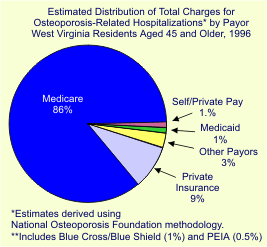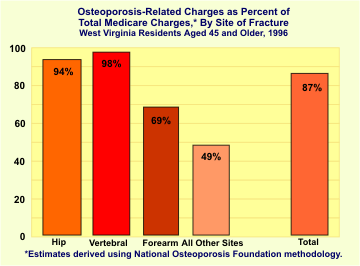The Burden of OSTEOPOROSIS in West Virginia
Contents
Exec. Sum.
Overview
Detection
Risk Factors
Prevention and Treatment
WV Prevalence
NOF Prevalence
Fractures Model
Hospitalizations
WV and US
Costs
Appendix A
Appendix B
Appendix C
Appendix D
References
OSTEOPOROSIS-RELATED HOSPITALIZATIONS
Osteoporosis Costs and Medicare
The costs to Medicare from osteoporosis are enormous. A recent report by Baron et al published in the Morbidity and Mortality Weekly Report analyzed excess costs to Medicare for 10 fracture sites (11). The study examined claims data for a 5% systematic sample (n=1,288,618) of Medicare beneficiaries aged 65 and older. Among those beneficiaries, a total of 26,785 fractures were identified. Costs incurred by each patient were calculated for a six-month period before the fracture, a 12-week period of care following the fracture, and a 40-week follow-up period. Expenses included in-patient hospitalization, physicians' fees, out-patient care facilities, skilled nursing facilities, home health agencies, and hospice care. Excess costs were calculated by comparing costs during the care and follow-up periods to the baseline period before the fracture. The findings showed that excess costs to Medicare ranged from $2564 following a wrist fracture to $15,294 following a hip fracture. For 1992, the total excess cost to Medicare was estimated at $4.2 billion, $2.9 (or 69%) of which was associated with hip fractures. This represented 3% of all Medicare costs for that year.
Osteoporosis-Related Hospitalization Charges in West Virginia
Estimated osteoporosis-related hospitalization costs in West Virginia in 1996 exceeded $42 million, nearly two-thirds (65%) of the total $66 million in hospital costs for all fractures among persons aged 45 and older. The bulk of the osteoporotic charges, or approximately 86%, was billed to Medicare, reflecting the age of the majority of osteoporosis sufferers. The pie chart below illustrates the approximate breakdown of charges for osteoporosis-attributable hospitalizations by payor: the remaining charges were billed to private insurance companies (9%), other payors (3%), Medicaid (1%), and self or private pay (1%).

Of the $42 million in osteoporosis-related hospitalization costs in 1996, an estimated $36 million were billed to Medicare. Hip fractures are more likely to occur among persons over the age of 65; therefore, while charges for hip fractures constituted two-thirds (66%) of total hospitalization charges, they represented nearly three-fourths (73%) of Medicare billings for osteoporotic fractures. The graph on the following page shows the osteoporosis-related percentage of Medicare charges for each type of fracture.

Approximately $47 million was billed to Medicare in 1996 for hospitalizations due to fractures among persons aged 45 and older. Of this, nearly $37 million (79%) was estimated to be osteoporosis related. As shown above, almost all (98%) of Medicare charges for vertebral fracture hospitalizations were attributable to osteoporosis, as were 94% of hip fracture charges, 69% of forearm fracture charges, and 49% of charges for other fractures. As the incidence of osteoporosis increases, so will the burden on the already stressed Medicare system.
It is vital to emphasize modification of the behaviors that lead to an increased risk of osteopenia and osteoporosis, as well as to improve interventions for fracture prevention. The disturbing projections given earlier in this report underscore the fact that the physical suffering, disability, tremendous health care costs, functional impairment, and mortality that result from osteoporosis will continue to increase steadily if action is not taken now to address the problem.
Back to Osteoporosis-Related Hospitalizations